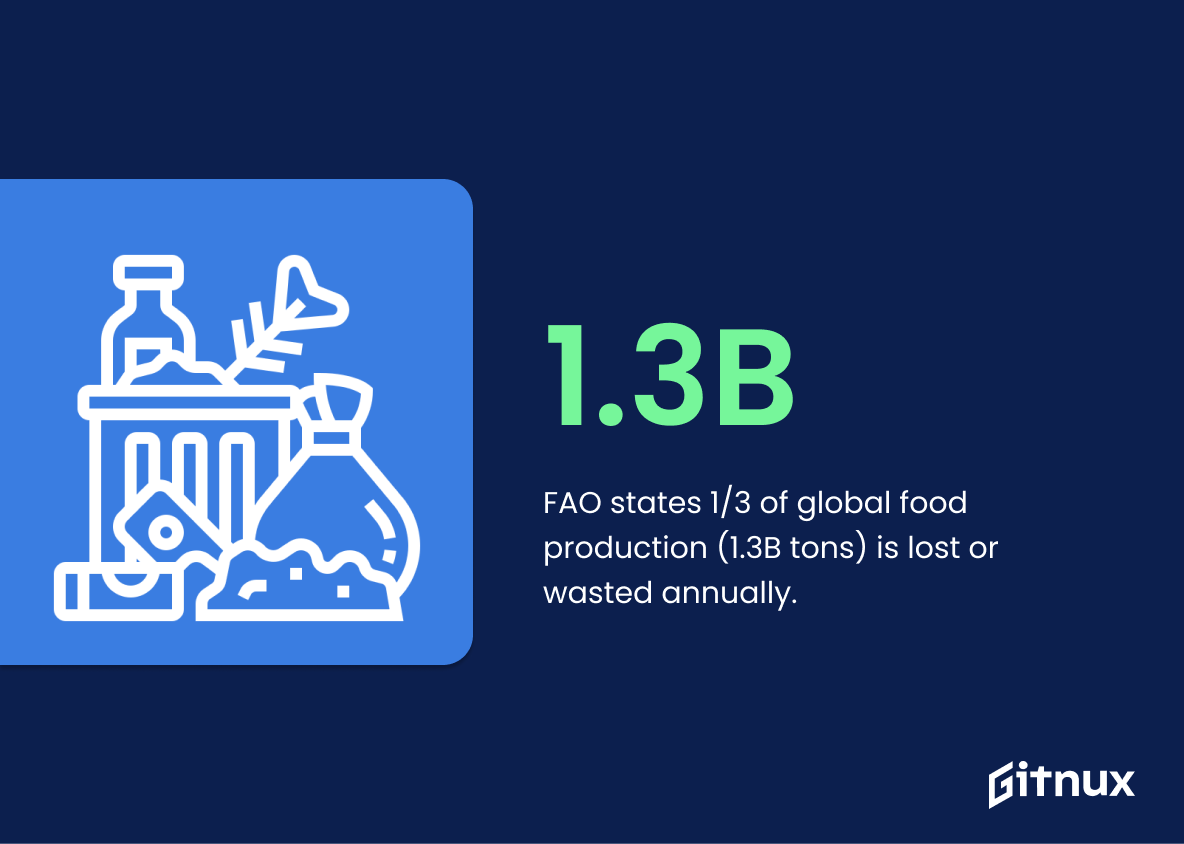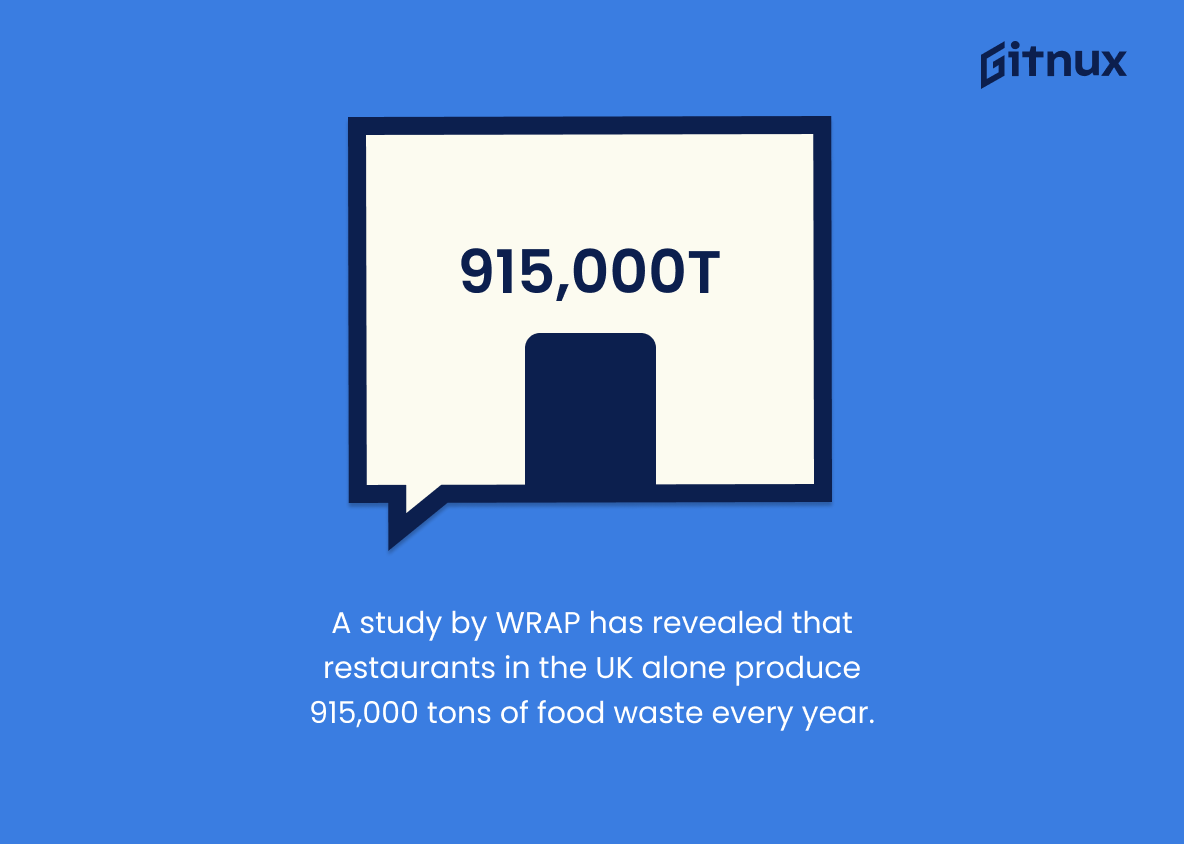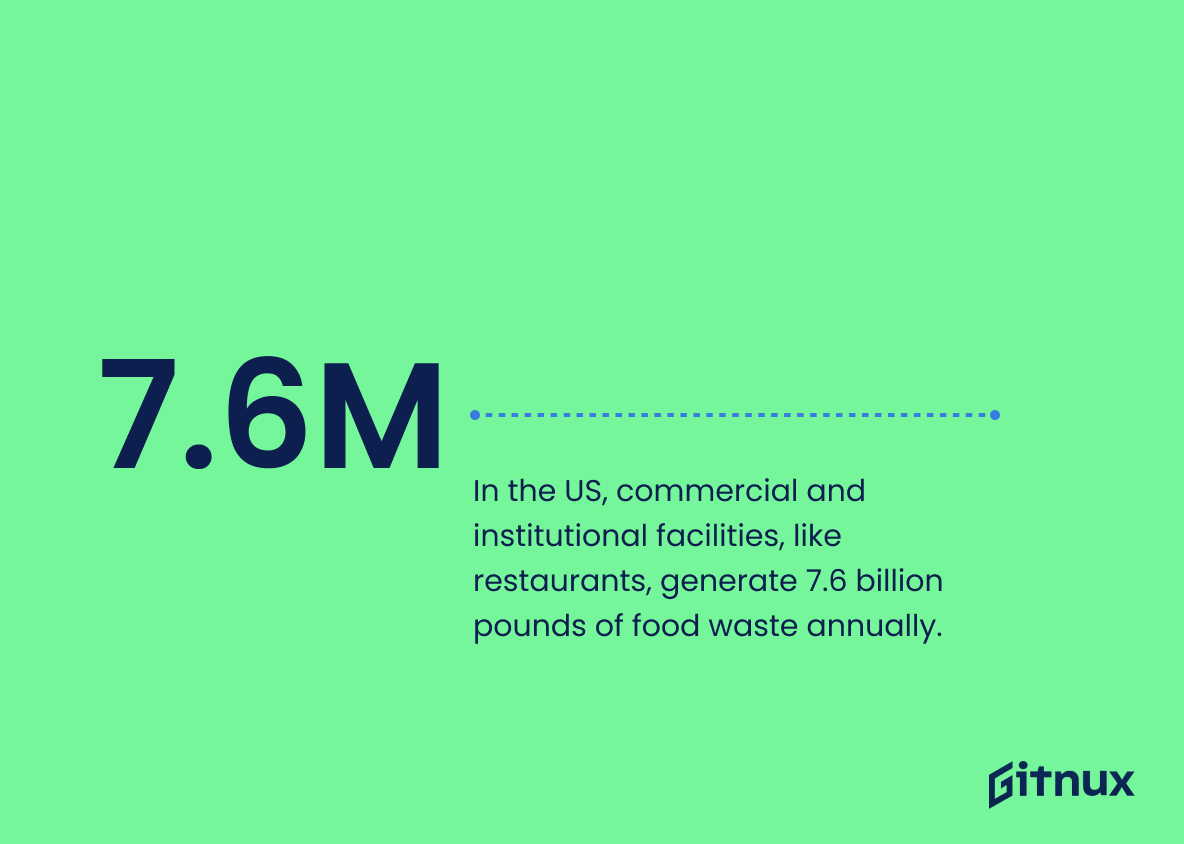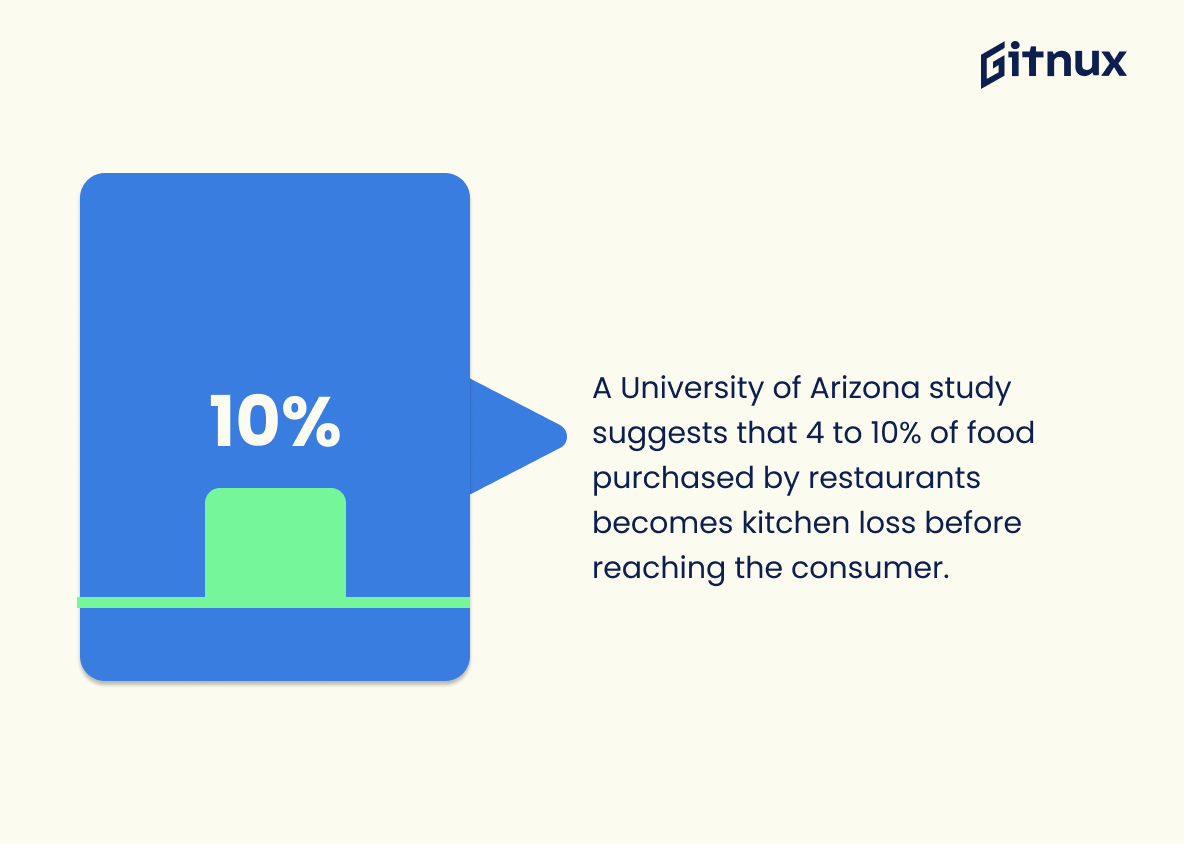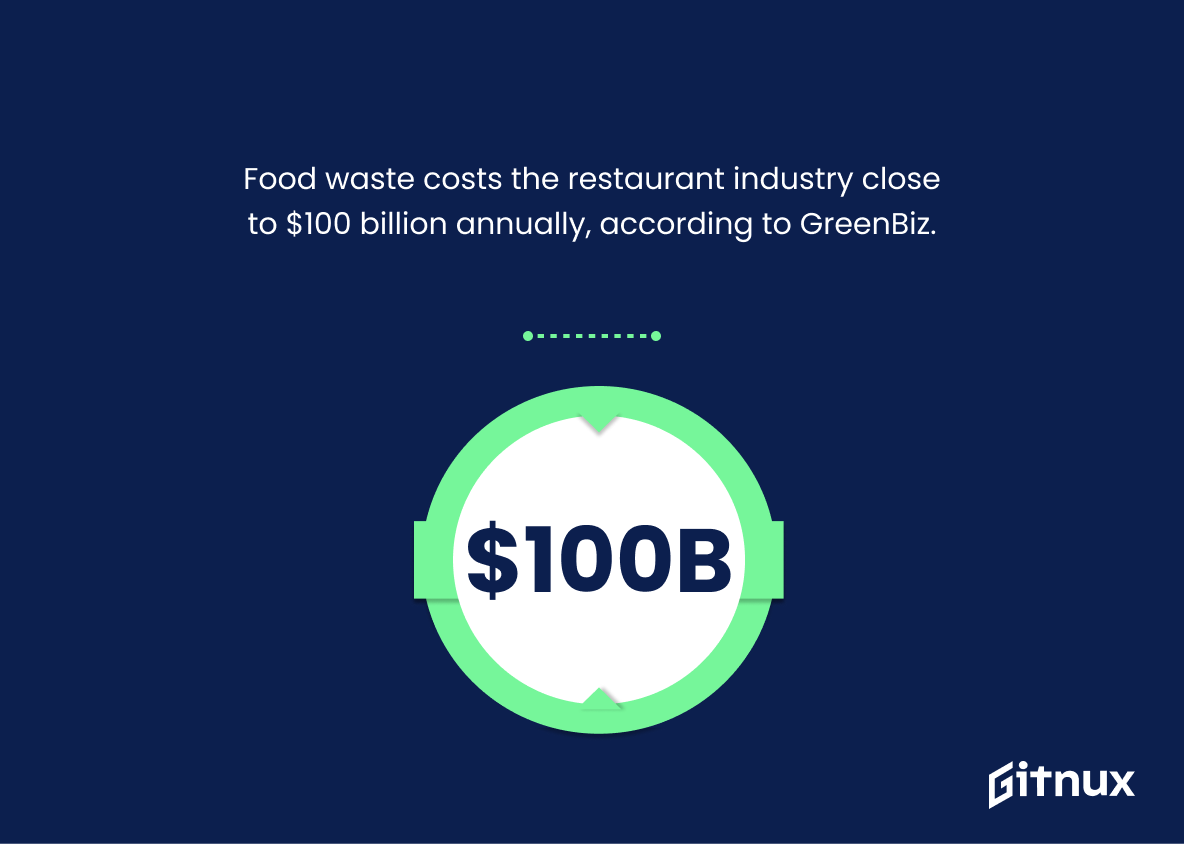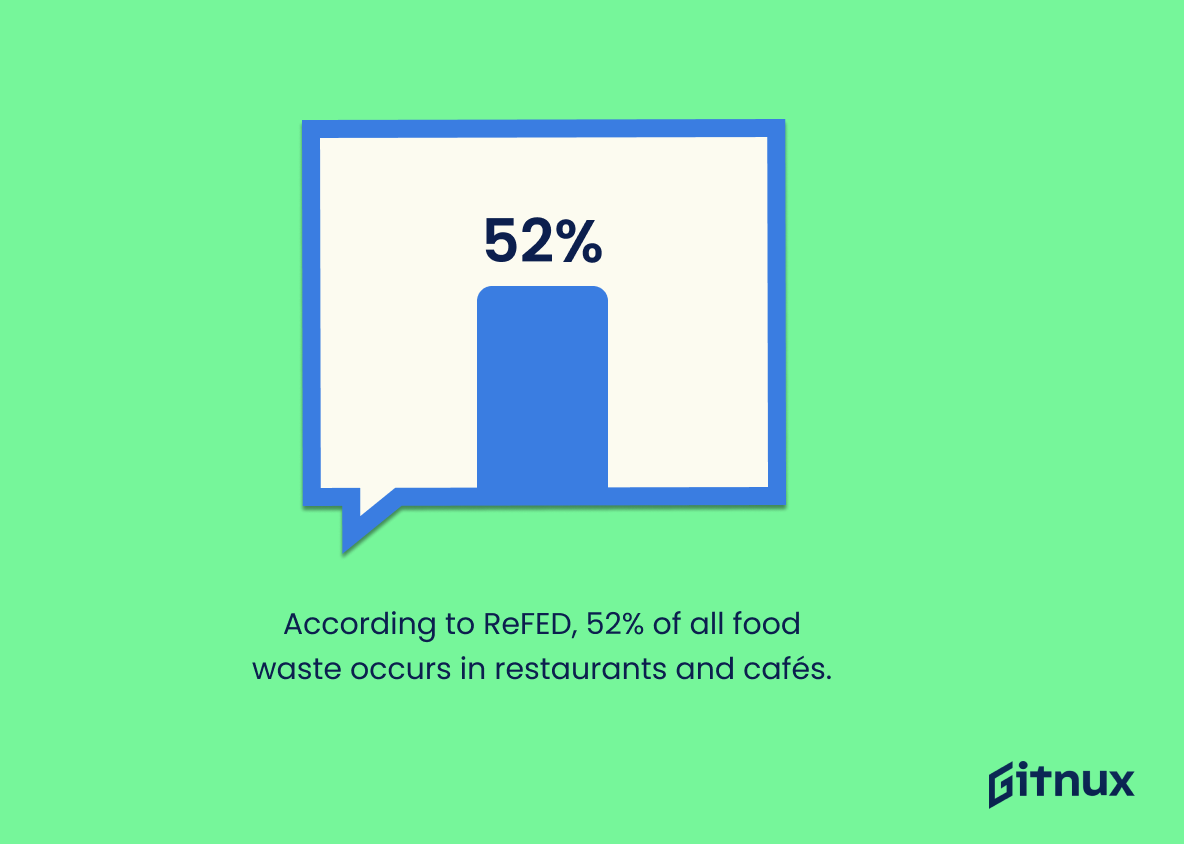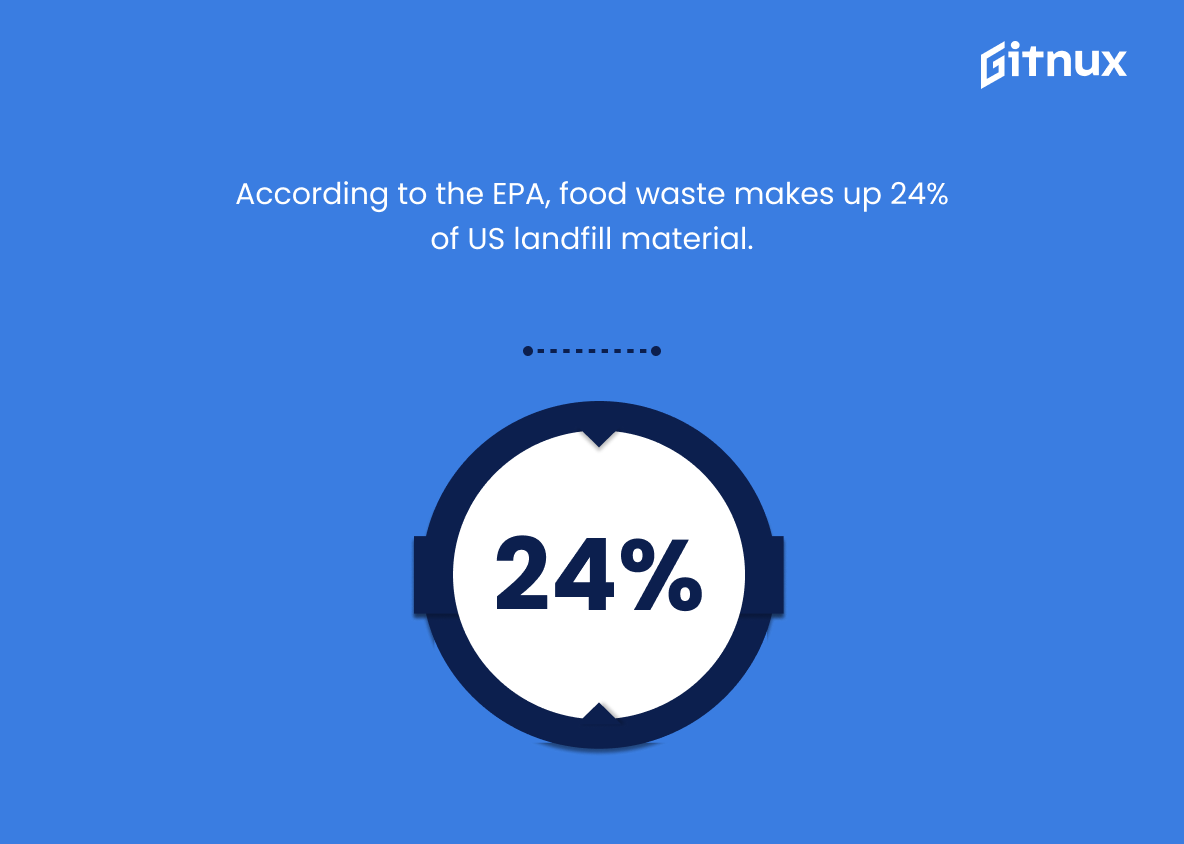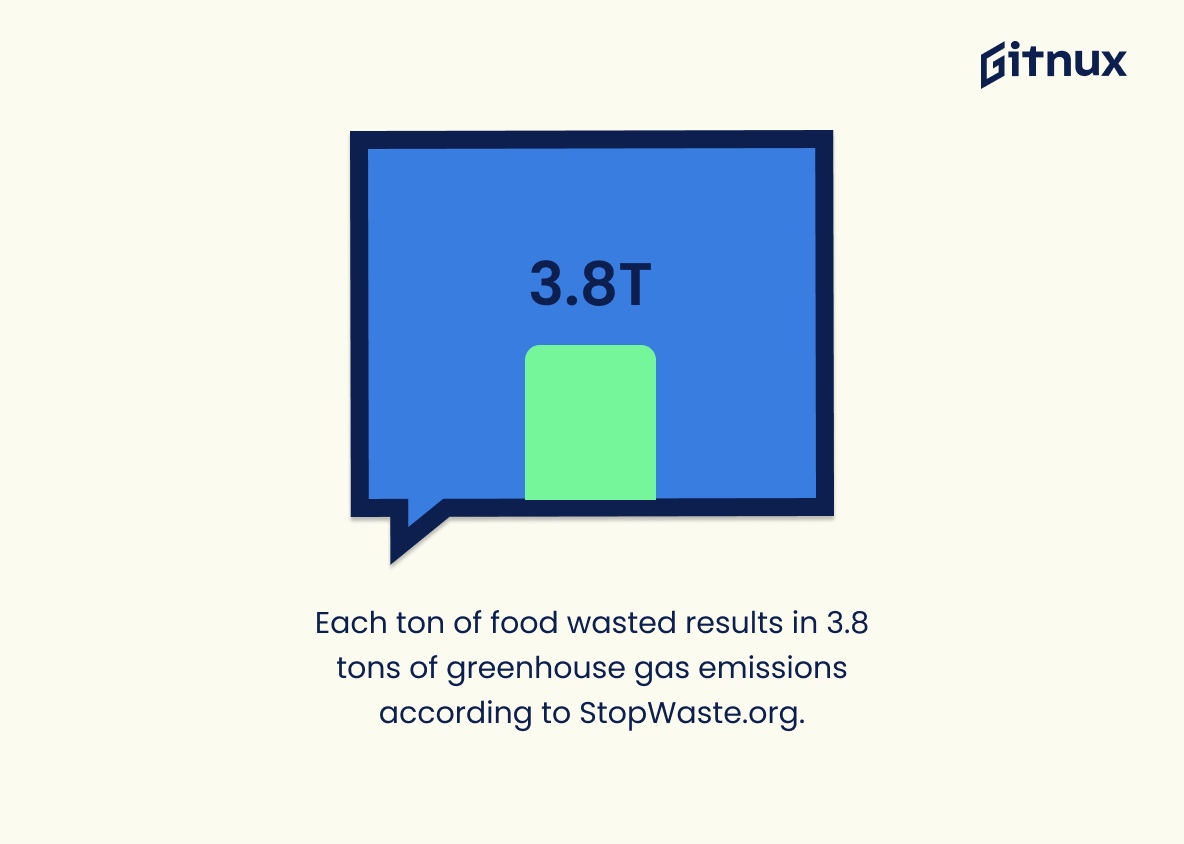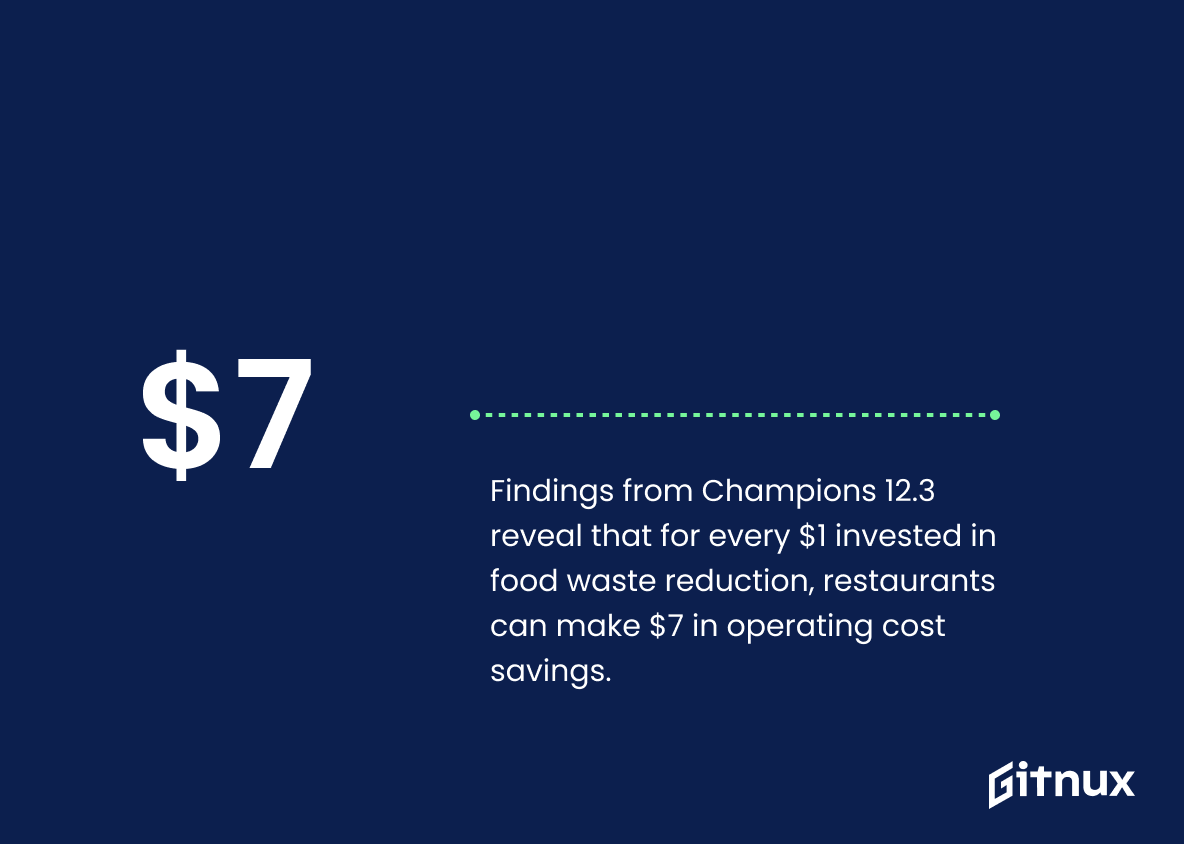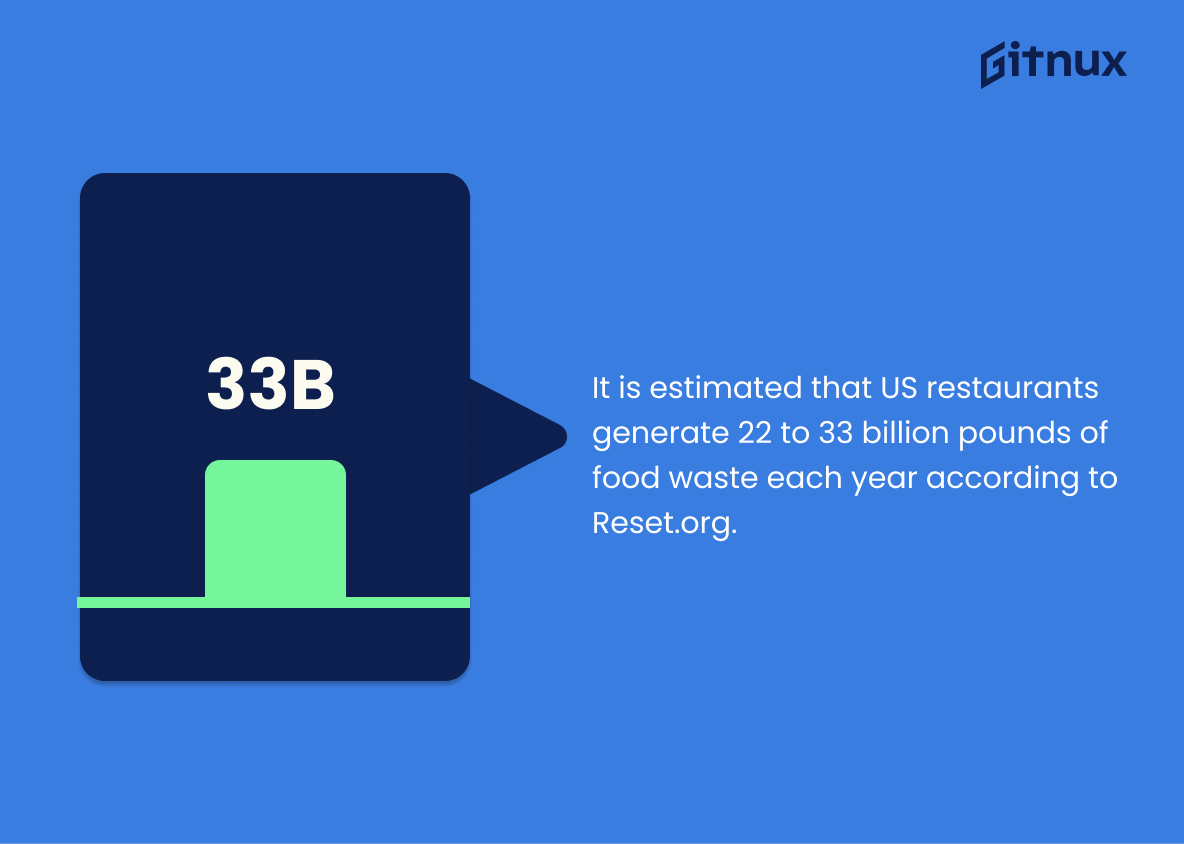Across the globe, the restaurant industry is constantly navigating the challenge of food wastage. Striking a balance between meeting customer demands and minimizing wastage is indeed a delicate task. This blog post aims to delve deep into restaurant food waste statistics, highlighting the magnitude of the issue, its environmental implications, and pointing towards innovative strategies restaurants are adopting to reduce their food waste footprint. In the midst of a world grappling with environmental concerns, understanding these statistics is the first step towards encouraging more sustainable practices in our eateries. After all, every morsel saved contributes to a greener, healthier planet.
The Latest Restaurant Food Waste Statistics Unveiled
According to the Food and Agriculture Organization (FAO), roughly one-third of the food produced globally for human consumption every year gets lost or wasted. That’s approximately 1.3 billion tons.
The FAO’s revelation serves as a stark reminder in the narrative of Restaurant Food Waste Statistics. It highlights the immense magnitude of the issue, placing emphasis on the alarming volume of wastage – a staggering 1.3 billion tons annually. By presenting such information, it serves as a potent eye-opener, underscoring the urgent need for action within restaurant operations to address food waste. This statistic is the pivot point around which discussions about better purchasing, preparation, portioning and preservation strategies should revolve. It’s not just a number, but a powerful wake-up call echoing throughout the restaurant industry.
A study by WRAP has revealed that restaurants in the UK alone produce 915,000 tons of food waste every year.
Unveiling the fathomless depth of the issue, the recent study by WRAP shares a harrowing tale – UK restaurants alone produce an astounding 915,000 tons of food waste annually. If we imagine this in terms of a concrete perspective, this figure has an intolerable environmental impact, squanders unparalleled economic potential, and blatantly disregards the plight of those enduring food poverty. The staggering statistic raises vital discussions about our current consumption patterns, cost and waste management efficiencies and serves as an eye-opening reminder of the urgent need to revolutionize our approach to food waste, starting from the heart of gastral extravagancy – our restaurants.
In the US, commercial and institutional facilities, like restaurants, generate 7.6 billion pounds of food waste annually.
Painting a picture of the enormous magnitude of waste, the statistic reveals that US commercial and institutional facilities, including restaurants, are responsible for an astounding 7.6 billion pounds of food waste annually. This staggering number serves as an eye-opening reality check. In a discourse surrounding restaurant food waste statistics, it underscores the gravity of the problem, creating an urgent backdrop for the necessity to respond and take suitable action. It’s like standing at the foot of a mountain, apprehending the colossal challenge that lies ahead, and preparing for the monumental hike towards creating sustainable solutions. It acts as a quantifiable pointer towards potential discussions about waste reduction strategies, sustainable practices, and the related economic, social, and environmental impacts. Expressed in pounds, the statistic outrightly speaks a language of concern, necessitating immediate intervention from restaurant operators, policy makers, environmentalists, and the society at large.
A University of Arizona study suggests that 4 to 10% of food purchased by restaurants becomes kitchen loss before reaching the consumer.
Illuminating perspectives on food waste in the restaurant industry can be drawn from a compelling study by the University of Arizona. Highlighting that a significant proportion of food – precisely between 4 to 10% – is lost in the kitchen before it ever reaches the consumer, the statistic reverberates as a powerful wake-up call for industry-wide improvements. When nestled within a blog post discussing Restaurant Food Waste Statistics, this nugget of information uncovers a hidden side of efficiency losses that could be improved upon to reduce both financial and environmental costs. It not only underscores the quintessential role of responsible sourcing and waste management practices but also sparks dialogues on innovative ways to repurpose or reduce kitchen loss. This serves to underscore the depth and breadth of the issue, while offering the potential for targeted solutions.
Food waste costs the restaurant industry close to $100 billion annually, according to GreenBiz.
Unearthing the astonishing figure of nearly $100 billion in food waste losses per annum casts a glaring spotlight onto the enormity and depth of the issue in the restaurant industry. This staggering amount not only epitomizes the economic implications, but also triggers a deeper discussion on sustainability, resource management, and profitability within the industry. In the context of a blog post on Restaurant Food Waste Statistics, this number becomes a powerful catalyst, stirring restaurateurs, stakeholders, and consumers to acknowledge, react, and hopefully devise innovative solutions to reduce this costly, undesirable excess.
According to the Green Restaurant Association, a single restaurant in the U.S. can produce approximately 25,000 to 75,000 pounds of food waste each year.
The statistic ‘According to the Green Restaurant Association, a single restaurant in the U.S. can produce approximately 25,000 to 75,000 pounds of food waste each year.’ serves as a significant wake-up call to all stakeholders in the restaurant industry. It is a vivid illustration of the sheer scale of food waste generated by eateries which plays a pivotal role in escalating global environmental and waste management issues. The magnitude of the food waste problem illuminated by this quantifiable evidence highlights essential opportunities for the industry toward more sustainable practices by reducing waste, thus contributing not only to economic savings, but also environmental preservation. This metric also underscores the need for restaurants to take more responsibility for their environmental footprint, potentially sparking changes in business models and practices for a more sustainable future in the food service sector.
According to ReFED, 52% of all food waste occurs in restaurants and cafés.
“Picture this: more than half of all food waste – a staggering 52%, as reported by ReFED – takes its last breath not in our homes, but in restaurants and cafés. This gripping statistic leaps out from the page and shatters any preconceptions we might have had about the level of waste generated in our favorite eateries. It’s time to sit up and take notice, because this figure sings an alarming tune about the sheer volume of food left uneaten in these establishments. Within the bustling kitchens and glittering dining rooms of restaurants and cafés, we uncover the hidden source of this mounting issue of food waste. Unmasking this truth is essential in shaping strategies to combat food wastage and, in our quest to reduce this percentage, every individual has a role to play.”
According to the World Resources Institute, reducing food loss and waste by 25% would be enough to feed 870 million hungry people in the world.
In the realm of restaurant food waste statistics, the figures presented by the World Resources Institute offer an enlightening revelation that highlights the power of change even in its simplest form. Picture this – a simple 25% reduction in food loss and waste can potentially solve the gnawing problem of hunger for an astounding 870 million people globally. Imagine then, the earth-shaking impact that the restaurant industry, known for its colossal waste, can make.
It’s not just about feeding the starving masses. It’s also about cultivating a culture of responsibility and sustainability that could echo through the labyrinth of the global food chain. It’s about transforming restaurants into agents of change—where every saved morsel contributes to a global annihilation of hunger. Therefore, these statistics act as clarion call, emphasizing the dire need for reducing food waste, while informing the restaurant industry of its underestimated potential to be part of an impactful solution.
Winnow, an AI research company estimates that wasted food could cost the global economy up to $1 trillion annually by 2030.
Highlighting Winnow’s estimation of global food waste potentially costing up to $1 trillion annually by 2030 unveils a startling economic repercussion that strikes a chord with every restaurateur. It provides a gritty backdrop to the discussion concerning restaurant food waste, urging readers to not only empathize with the environmental consequence but also grasp its substantial economic implication. Lacing our blog post with this perspective, we weave a compelling narrative that resonates with restaurant owners, nudging them to reconsider their waste management strategies, thus potentially alleviating a global economic burden.
According to the EPA, food waste makes up 24% of US landfill material.
Unpacking the significant figure from the EPA that 24% of US landfill material is made up of food waste provides a thought-provoking basis for our discussion about restaurant food waste statistics. In the bustling kitchens of US restaurants – from fine dining to fast food – it’s not hard to fathom how this startling statistic comes to light. Each plate returned with unconsumed food, every overfilled buffet, all contribute to this environmental footprint. It underlines the imperative to explore, understand, and consciously tackle food waste in the restaurant industry. Highlighting the magnitude of the issue, it beckons restaurant owners, customers, and nationwide food chains to take initiative in reducing their contribution to the waste stream. As we peel back layers of data and dissect the numbers, this striking figure forms a compelling backdrop for actionable change towards sustainable food service practices.
The carbon footprint of food produced and not eaten is estimated at 3.3 Gtonnes of CO2. That would make food waste the third top emitter after USA and China according to FAO.
This compelling statistic magnifies the role that food waste plays in global carbon emissions, catapulting it to an alarming third position, right behind the titanic economies of the USA and China. In the context of a blog post on Restaurant Food Waste Statistics, it underlines the urgency to curtail food wastage in the restaurant industry. It paints a vivid picture of how each unconsumed morsel contributes to an immense, invisible cloud of CO2, ingraining a deeper understanding and significance of reducing food waste. Emphasizing this chilling fact helps drive home the importance of conservatively managing restaurant resources and adopting sustainable practices to decrease carbon footprints. The weight of this statistic could well be a wake-up call for restaurateurs to drastically rethink their food waste strategies, transforming from mere business establishments to environmental stewards.
Each ton of food wasted results in 3.8 tons of greenhouse gas emissions according to StopWaste.org.
Fancy a whirlwind trip into the staggering realm of restaurant food waste statistics? If so, strap in and digest this alarming fact: each ton of food wasted is responsible for 3.8 tons of greenhouse gas emissions according to StopWaste.org. An overlooked consequence, indeed.
Now ponder this further within the context of a bustling eatery. An environment where heaps of uneaten meals and unused ingredients quietly turn into a potent contributor to our lurking climate crisis. The high numbers in greenhouse gas emissions resulting from such waste only serve to flavor the bitter recipe of global warming, making it much more than just throw-away food — it’s throwing away our planet’s health.
So next time you witness food waste in the otherwise exciting world of restaurants, remember: it’s not just about wasted resources, lost profits, or ethical concerns of hunger. It’s about our planet literally warming, a silent, invisible hazard — all courtesy of that discarded food. Why do the stats matter? They give us a glimpse into the weight of our actions while providing a starting point for impactful, environmentally-friendly changes going forward. Join us as we delve deeper into the story these numbers tell.
Findings from Champions 12.3 reveal that for every $1 invested in food waste reduction, restaurants can make $7 in operating cost savings.
Imagine a restaurant establishing an innovative waste reduction program and reaping seven times the initial investment in operating cost savings. This is not mere speculation- Champions 12.3’s findings confirm it. Defying the conventional wisdom that reducing food waste is costly and time-consuming, these metrics illuminate a compelling path to profitability and sustainability for restaurants worldwide. They decimate the deterrents of hefty investment concerns. Instead, they project a powerful business case for efficiency by turning each dollar invested in waste reduction into seven dollars of operating cost savings. So, in a blog post about Restaurant Food Waste Statistics, this statistic isn’t just a number; it’s a beacon guiding sensible decision-making while emphasizing environmentally responsible practices for restaurateurs.
It is estimated that US restaurants generate 22 to 33 billion pounds of food waste each year according to Reset.org.
Unwrapping this hefty statistic draws attention to a staggering issue in our dining culture: That US restaurants are at the epicenter of an enormous 22 to 33 billion pounds of food waste generated annually, as indicated by Reset.org. Emphasizing these numbers paints a glaring portrait of the voluminous wastage linked to our culinary businesses, laying the groundwork for a compelling read about restaurant food waste statistics. Reveling in the harsh reality of these facts deepens our understanding of the issue, compelling us not only to digest the numbers, but also to explore tangible solutions and preventative measures in managing restaurant waste. This shocking revelation can stir readers to action, whether through promoting more sustainable practices among restaurant owners, or influencing customers’ dining habits, ultimately contributing to a global step towards significant waste reduction.
Roughly 40% of food in the U.S. goes to waste, and a significant portion of that comes from restaurants, according to the National Resources Defense Council.
Surely, the statement that approximately 40% of food in the U.S., including a significant portion from restaurants, finds its way into the garbage gives pause. In the grand narrative of restaurant food waste statistics, it’s a shocking protagonist. The high degree of waste highlights the profound inefficiency within our food distribution and consumption systems, where resources are wasted on a massive scale. The statistic is a resonating thunderclap to restaurateurs, customers, and environmentalists alike that our dining habits come with weighty environmental costs. It underscores the urgent need for more sustainable practices in the restaurant industry, from food preparation to portion sizes to leftovers management. This statistic acts as a compelling call to revolutionize our dining culture to reduce, reuse, and recycle in every possible way.
According to the World Wildlife Fund, wasted food in the foodservice sector — which includes restaurants — is estimated at 52% of all food.
Underlining the gravity of the situation, the World Wildlife Fund’s revelation paints a stark picture of widespread food waste in the restaurant industry, with a staggering estimate of 52%. This eye-opening figure doesn’t just indicate a woeful lack of food efficiency within our eateries; it serves as a wake-up call for businesses, stakeholders, and consumers to address and rectify this alarming trend. It emphasises the urgent need to reassess current practices, implement waste reduction strategies, and promote sustainability within the sector, whilst stimulating a dialogue on a global scale about responsible consumption for the good of our planet.
A USDA report states that the amount of uneaten food in homes and restaurants was valued at $161 billion in 2010.
Highlighting the USDA report’s staggering revelation of $161 billion worth of uneaten food in homes and restaurants back in 2010 breathes life into the harsh reality of food wastage in the restaurant sector. Such a formidable figure catapults the narrative to a whole new level, evoking a sense of urgency and prompting readers to rethink their consumption habits. Rooted in reality, this figure serves as a potent reminder of the financial implications of food waste and triggers a call for immediate rectification both in our homes and in the restaurant industry. It turns a spotlight on the economic loss that could, in essence, be transformed into savings or redirected into other essential sectors, thereby adding a unique perspective to the restaurant food waste conversation.
A report from LeanPath indicates an average food waste cost at full-service restaurants is roughly $155,00 annually.
In the panorama of restaurant food waste, the statistic from LeanPath, highlighting an annual average cost of approximately $155,000, paints a startling yet enlightening picture. This figure is more than a bland numerical data point; it is a clarion call that underscores the economic implications of food waste in full-service restaurants. It speaks volumes about the scale of the issue, reinforcing the urgency to devise effective strategies for waste management. The statistic acts as a poignant reminder in our blog post, shedding a harsh light on the cost of negligence, inefficiency, and lack of sustainability in the restaurant industry, and propelling our discussion towards actionable solutions.
The Food Waste Reduction Alliance (FWRA) found that 84.3% of unused food in American restaurants ends up being disposed of, while 14.3% is recycled, and only 1.4% is donated.
Drilling into the epicenter of the puzzle concerning restaurant food waste statistics, the discovery by the Food Waste Reduction Alliance (FWRA) unveils an alarming narrative. Highlighting that a massive 84.3% of unused food in American eateries is discarded paints a distressing portrait of squander and missed opportunities for better usage or recycling.
Pivoting to the brighter side of the prism, we observe 14.3% of unused food making its way admirably into the recycling stream – a silver lining, perhaps, underscoring the potential for responsible waste management. Nonetheless, seeing this value juxtaposed with the staggering waste figure drives home the point that there is a vast room for improvement in optimizing food utilization and minimizing waste.
The final piece of the FWRA’s revelation – the minuscule 1.4% donation figure – serves as a wake-up call, reminding us that a substantial opportunity is being overlooked. Given the multitude of hungry mouths and food aid programs around us, enhancing food donation efforts could convert waste into sustenance for those in need.
Thus, each facet of this statistic delivers a significant punch in the narrative of restaurant food waste, acting as a potent igniter for conversations and actions revolving around sustainability, responsibility, and community support in the restaurant industry.
A survey by Business Waste stated that 600,000 tonnes of food waste from restaurants could be avoided each year in the UK.
Highlighting the statistic of 600,000 tonnes of food waste that could be evaded annually in the UK draws a sharp focus on the staggering magnitude of food being wasted at restaurants, striking at the heart of sustainability concerns. This colossal figure serves as a stark and vital reminder of the indispensable role restaurants play in curbing food waste. It unearths the areas of potential improvement in the restaurant industry’s supply chain, inventory management, and portion sizes, lending urgency to the pursuit of preventive strategies and sustainable solutions. Thereby, it underlines the gravity and scope of the issue, propelling readers to understand, respond, and actively participate in mitigating food waste.
Conclusion
The statistics surrounding restaurant food waste are both alarming and enlightening. They illuminate the vast extent of waste generated by the restaurant industry—an issue that requires immediate and concerted effort to resolve. As the data strongly indicates, effective waste management strategies can lead to considerable cost savings and help establish more sustainable practices. Therefore, each player in the restaurant industry is accountable for acting responsibly, reducing waste, and contributing to a more sustainable future. We should not look at this as a mere option but as our collective responsibility towards our planet and future generations.
References
0. – https://www.www.winnowsolutions.com
1. – https://www.champions123.org
2. – https://www.www.greenbiz.com
3. – https://www.cals.arizona.edu
4. – https://www.en.reset.org
5. – https://www.wrap.org.uk
6. – https://www.www.fao.org
7. – https://www.www.dinegreen.com
8. – https://www.www.nrdc.org
9. – https://www.blog.leanpath.com
10. – https://www.www.foodwastealliance.org
11. – https://www.www.epa.gov
12. – https://www.www.worldwildlife.org
13. – https://www.www.businesswaste.co.uk
14. – https://www.www.refed.com
15. – https://www.www.wri.org
16. – https://www.www.usda.gov
17. – https://www.www.stopwaste.org
